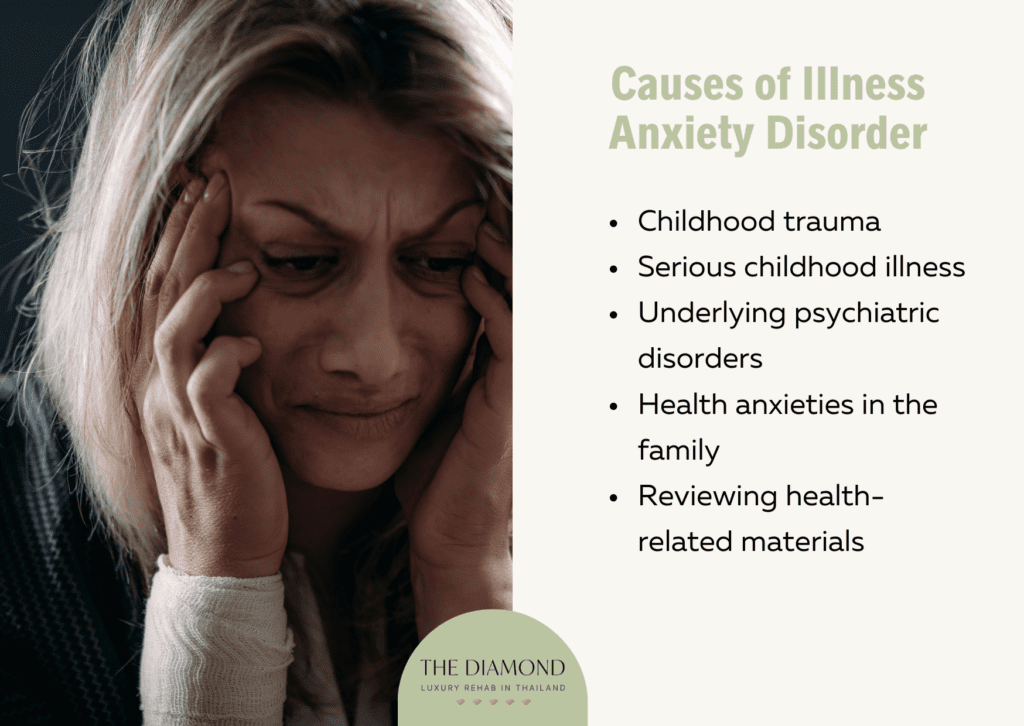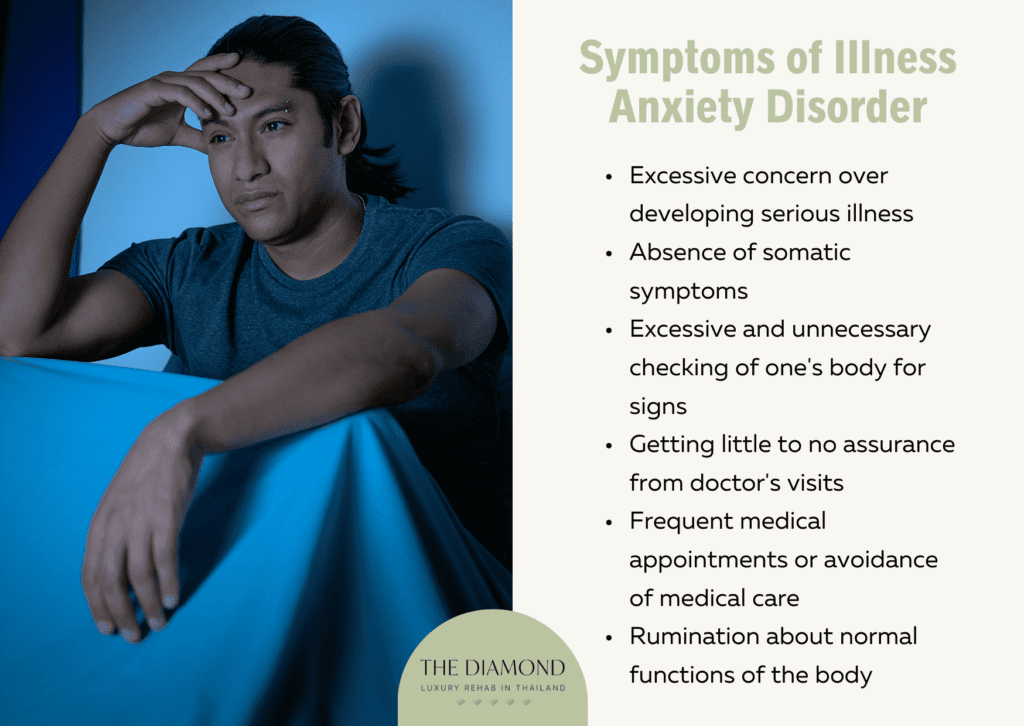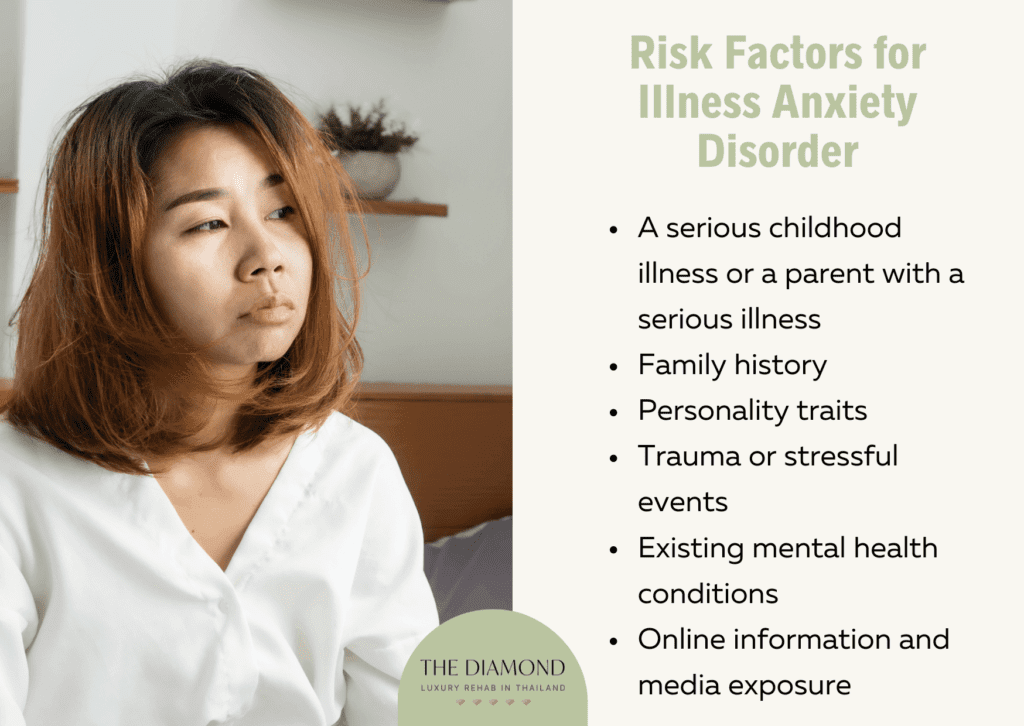Illness anxiety disorder: definition, causes, symptoms, and treatments
Table of content
- What is illness anxiety disorder?
- What are the causes of illness anxiety disorder?
- What are the symptoms of illness anxiety disorder?
- 1. Excessive concern over developing serious illness
- 2. Absence of somatic symptoms
- 3. Excessive and unnecessary checking of one’s body for signs
- 4. Getting little to no assurance from doctor’s visits
- 5. Frequent medical appointments or avoidance of medical care
- 6. Rumination about normal functions of the body
- Who is affected by illness anxiety disorder?
- What are the risk factors for illness anxiety disorder?
- How is illness anxiety disorder diagnosed?
- What are the treatments for illness anxiety disorder?
- Can illness anxiety disorder be prevented?
- What is the difference between illness anxiety disorder and Munchausen syndrome?
- What is the difference between illness anxiety disorder and somatic symptom disorder?

Illness anxiety disorder is a mental health condition characterized by an excessive preoccupation and fear of having a serious illness despite minimal or no symptoms. Individuals with this disorder often misinterpret bodily sensations as signs of a severe disease, leading to persistent worry and anxiety about their health.
The causes of illness anxiety disorder are multifaceted, including childhood trauma, serious childhood illness, underlying psychiatric disorders, health anxieties in the family, and reviewing health-related materials.
Symptoms of illness anxiety disorder commonly include excessive concern over developing serious illness, absence of somatic symptoms, excessive and unnecessary checking of one’s body for signs, getting little to no assurance from doctor’s visits, frequent medical appointments, or avoidance of medical care, and rumination about normal functions of the body.
Treatments for illness anxiety disorder are psychotherapy and pharmacotherapy. Therapies are tailored to the severity of the individual’s condition and medical history. Cognitive-behavioral therapy is the primary treatment approach, focusing on addressing the dysfunctional thoughts and behaviors associated with illness anxiety disorder. Medications are employed in more severe cases to alleviate anxiety and manage symptoms.
What is illness anxiety disorder?
Illness anxiety disorder (IAD), also known as hypochondriasis or health anxiety, is a chronic psychological disorder characterized by excessive worry or fear of having a serious medical condition, despite having minor or no medical symptoms and consistently negative diagnostic tests, as defined by Mayo Clinic’s 2021 issue, titled“Illness anxiety disorder”.
The article further reveals that people may interpret minor sensations as signs of severe illness, causing extreme distress that disrupts daily life. This condition can vary in intensity and may worsen with age or stress.
As per the 2017 issue of the Journal of Psychosomatic Research, titled “DSM-5 illness anxiety disorder and somatic symptom disorder: Comorbidity, correlates, and overlap with DSM-IV hypochondriasis”, DSM-5 characterized IAD as a condition marked by an overwhelming preoccupation with the fear of contracting or having severe illnesses, coupled with heightened health-related distress and observable behavioral indicators like avoiding specific situations and frequently checking one’s body. Those identified with IAD fall into distinct categories: care-seeking individuals who excessively pursue medical intervention and care-avoidant individuals who rarely seek medical assistance.
What was illness anxiety disorder previously called?
Illness anxiety disorder was previously called hypochondriasis in the Diagnostic and Statistical Manual of Mental Disorders (DSM), Fourth Edition (DSM-4).
The classification of hypochondriasis according to DSM-4 faced criticism due to its excessively specific criteria, making it difficult to apply in actual clinical settings. To address these issues, DSM-5 introduced two alternative conditions, namely illness anxiety disorder and somatic symptom disorder, each outlined with their respective criteria as a replacement for hypochondriasis, as highlighted in the 2017 issue of the Journal of Psychosomatic Research, titled “DSM-5 illness anxiety disorder and somatic symptom disorder: Comorbidity, correlates, and overlap with DSM-IV hypochondriasis”.
How common is illness anxiety disorder?
Illness anxiety disorder is very uncommon, impacting roughly 0.1% of the American population. This disorder tends to manifest during the early stages of adulthood but can affect individuals of any age or gender, as highlighted in the 2021 article “Illness Anxiety Disorder (Hypochondria, Hypochondriasis)” by the Cleveland Clinic.
According to a 2018 Medscape article titled “Illness Anxiety Disorder (formerly Hypochondriasis),” in the United States, the estimated prevalence of illness anxiety disorder within the community spans from 1.3% to 10% over a 1 to 2-year period. Likewise, in medical outpatient settings, the estimated prevalence ranges between 3% and 8% over a 6-month to 1-year period.
CertaPetconducted a survey in November 2021 to delve into health anxiety in the United States, gathering substantial evidence by polling 800 individuals nationwide. Upon analyzing the data, a clear trend emerged: health anxiety was on the rise among Americans. Approximately 75.6% of respondents reported experiencing increased health anxiety compared to their feelings five years prior. Among American women, 67.7%—more than two in every three—acknowledged experiencing health anxiety. Notably, one in three American women mentioned that COVID-19 pandemic significantly impacted their health anxiety levels.
What are the causes of illness anxiety disorder?

The potential causes of illness anxiety disorder are listed below.
- Childhood trauma
- Serious childhood illness
- Underlying psychiatric disorders
- Health anxieties in the family
- Reviewing health-related materials
1. Childhood trauma
Childhood trauma or maltreatment refers to various types of emotional and/or physical abuse, sexual abuse, neglect, negligent treatment, commercial exploitation, or any other form of harm to a child’s health, development, survival, or dignity within a relationship involving responsibility, trust, or power, as defined in Jacqueline G.F.M. Hovens‘ 2015 thesis titled “Emotional Scars: Impact of Childhood Trauma on Depressive and Anxiety Disorders.”
The study also claimed that the experience of childhood trauma increases the likelihood of developing depressive and anxiety disorders like illness anxiety disorder, as individuals exposed to such early adverse experiences may carry persistent anxiety and hypervigilance towards health matters, which carry significant mental health consequences later in life.
2. Serious childhood illness
Serious childhood illness refers to any severe, long-term, or life-threatening medical condition that affects children. These illnesses often require extensive medical care, treatments, and support to manage and can have a profound effect on a child’s development and overall quality of life.
The experience of serious childhood illness could lead to the perception that physical sensations are alarming and provoke fear in individuals, according to Mayo Clinic‘s 2021 release on “Illness Anxiety Disorder”.
Witnessing a loved one endure a severe illness or pass away due to a serious health condition can significantly contribute to persistent preoccupation with the possibility of being seriously ill, leading to the development of IAD.
3. Underlying psychiatric disorders
Underlying psychiatric disorders refer to mental health conditions that are not immediately evident but exist beneath the surface, contributing to or influencing a person’s thoughts, emotions, behaviors, or overall mental well-being.
As per The Center for Treatment of Anxiety and Mood Disorders’ 2022 publication titled “Signs You May Be A Hypochondriac,” around two-thirds of hypochondriacs or individuals with illness anxiety disorder experience a concurrent psychiatric condition, such as panic disorder, obsessive-compulsive disorder (OCD), or major depression.
Individuals with heightened anxiety might interpret ordinary bodily sensations as signs of a severe illness, leading to persistent worry and distress. Similarly, individuals with depression might fixate on physical symptoms, perceiving them as confirmation of a serious ailment. OCD tendencies can also contribute to the development of IAD, as the preoccupation with health and constant checking for symptoms may exacerbate concerns, further reinforcing the fear of being sick.
4. Health anxieties in the family
Health anxieties in the family refer to an environment where concerns or fears related to health problems are prevalent. When individuals are consistently exposed to heightened worries or preoccupations about health issues within their family, it can subconsciously contribute to the development of illness anxiety disorder, leading to adopting similar patterns of behavior, such as frequent checking of symptoms or seeking unnecessary medical tests, and influence an individual’s perception of health.
In a 2019 case report article by Frontiersin Psychiatry journal titled “Severe Illness Anxiety Treated by Integrating Inpatient Psychotherapy With Medical Care and Minimizing Reassurance”, researchers presented a patient who encountered multiple health challenges in her family within two years. Most notably, her brother experienced an unexpected death shortly after doctors told him that he was clear of a severe illness. Moreover, her family struggled with various health issues at that time, including diagnoses like cancer, stroke, retinal detachment, bipolar disorder, and several instances of suicide.
This woman developed severe IAD following her son’s hospitalization for influenza, leading to excessive worry about her health and her loved ones. She spent hours researching symptoms online and frequently visited the emergency room (ER) despite reassurance from medical tests.
5. Reviewing health-related materials
Reviewing health-related materials refers to extensively examining medical articles, websites, or resources, often concerning various illnesses, symptoms, or health conditions. Continuously seeking out health information can lead to heightened anxiety, overinterpretation of minor bodily sensations, and a persistent belief in having a severe medical condition. This constant focus on health materials may reinforce or exacerbate fears and concerns, fueling the cycle of anxiety and hypervigilance about one’s health.
As per the 2007 article “Cognitive and perceptual variables in hypochondriasis and health anxiety: A systematic review” by Clinical Psychology Review, exposure to materials related to illness can lead to heightened hypochondriacal concerns or anxiety among individuals who are already anxious about their health.
What are the symptoms of illness anxiety disorder?

The symptoms of illness anxiety disorder are listed below.
- Excessive concern over developing serious illness
- Absence of somatic symptoms
- Excessive and unnecessary checking of one’s body for signs
- Getting little to no assurance from doctor’s visits
- Frequent medical appointments or avoidance of medical care
- Rumination about normal functions of the body
1. Excessive concern over developing serious illness
Excessive concern over developing a severe illness refers to an intense, persistent preoccupation or fear of getting sick, despite mild or no symptoms.
In illness anxiety disorder, this symptom is marked by an individual’s constant worry or belief that they have or will develop a severe illness. Even when medical reassurance or tests indicate no significant health issue, the anxiety and distress persist, as described in Mayo Clinic’s 2021 issue, titled “Illness anxiety disorder”.
According to the 2018 article “Illness Anxiety Disorder (formerly Hypochondriasis) Clinical Presentation” by Medscape, the cognitive model of illness anxiety disorder proposes that individuals with this condition tend to misinterpret bodily sensations, amplifying normal physical feelings into significant concerns about having a serious illness.
They often have less tolerance for physical discomfort. What might be perceived by most people as mild discomfort could be exaggerated by those with illness anxiety into severe pain. When they experience even minor injuries, it causes significant anxiety and reinforces their fear of being seriously ill. This is possibly because they tend to overestimate their susceptibility to diseases and the likelihood of having a severe illness, amplifying their worries about health issues.
2. Absence of somatic symptoms
The absence of somatic symptoms refers to the lack of evident physical signs of illness or disease in an individual, despite their excessive preoccupation and worry about having a severe medical condition.
In a 2023 article “Illness anxiety disorder: What is hypochondria?”, the authors T. Welsh and J. Crosby illustrated how individuals with illness anxiety disorder tend to amplify minor physical discomfort in their back to be a fractured vertebra, spinal fluid leakage, or another serious back condition, despite any physical symptoms.
These individuals often perceive these discomforts as signs of a severe condition, persisting in their belief despite medical reassurance or evidence suggesting otherwise.
3. Excessive and unnecessary checking of one’s body for signs
Excessive and unnecessary checking of one’s body for signs refers to repeatedly and persistently examining oneself for perceived symptoms, often to an extreme degree that goes beyond what is considered normal or necessary.
As per 2019 study by Clinical Psychology: Science and Practice, titled “Online health research and health anxiety: A systematic review and conceptual integration”, maladaptive beliefs about health and illness persist due to different cognitive and behavioral factors, like memory biases, attentional focus, and a style of repetitive thinking. Individuals engage in behaviors aiming to prevent feared outcomes or reduce anxiety symptoms, such as excessive body checking, avoiding activities perceived as risky, and seeking reassurance from external sources. The study suggests that these safety behaviors related to health reinforce negative beliefs and contribute to the maintenance of IAD or health anxiety.
4. Getting little to no assurance from doctor’s visits
Getting little to no assurance from doctor’s visits refers to a situation where an individual, despite seeking medical attention, does not feel convinced by the medical professionals’ opinions, examinations, or test results.
The 1989 Washington Post article “HYPOCHONDRIA” pointed out that individuals with IAD often feel dissatisfied and mistrustful of medical care, suspecting doctors of deliberately withholding information. This creates a frustrating cycle for both patients and physicians. Doctors, striving to offer assistance, can become frustrated and annoyed when dealing with such patients, as hypochondria poses a challenge to medical practitioners.
Doctors see these individuals as burdens with irrational demands, challenging to reassure, and time-consuming. On the other hand, patients hold grievances against multiple doctors they consult, feeling their suffering is not taken seriously. Even when medical tests reveal no physical ailment, a significant number of patients continue to suffer.
This persistent lack of reassurance from medical professionals contributes to their ongoing health anxiety and can significantly impact their daily lives and well-being.
5. Frequent medical appointments or avoidance of medical care
Frequent medical appointments or avoidance of medical care in the context of illness anxiety disorder represent two ends of a spectrum concerning health-seeking behavior.
As per Cleveland Clinic’s 2021 article, titled “Illness Anxiety Disorder (Hypochondria, Hypochondriasis),“ individuals with IAD typically fall into one of these classifications: healthcare-seeking and healthcare-avoidant. Healthcare-seeking people frequently pay visits to various doctors, spend considerable time in medical environments, consult multiple specialists, and request various medical tests for their health concerns even when there is little or no medical basis.
Conversely, in the healthcare-avoidant category, individuals tend to steer clear of doctors and medical care. There is often a lack of trust in medical professionals, or a belief that their symptoms are not taken seriously. Some individuals fear confirming their perceived health issues or worry about receiving a serious diagnosis.
6. Rumination about normal functions of the body
Rumination about normal bodily functions refers to a persistent concern with regular physiological activities, often interpreting them as abnormal or indicating an underlying illness. It is a key characteristic of hypochondriasis, marked by an overwhelming fear of having a severe illness. It is also associated with various psychological conditions such as depression, anxiety, stress, bulimic behaviors, and substance abuse, as highlighted in the 2008 issue of the Journal of Psychosomatic Research, titled “Health anxiety, rumination, and negative affect: A mediational analysis”.
Research indicates that this persistent pattern of overthinking can influence both mental health and physical well-being, potentially leading to elevated stress responses, increased heart rate, higher cortisol levels, and heightened immune reactions. As rumination is strongly connected to depression and given the significant overlap between hypochondriasis and depression, the relationship between rumination and health anxiety might be influenced by the shared variance.
Who is affected by illness anxiety disorder?
Illness anxiety disorder can affect individuals of any age, background, or gender. However, it typically begins during the early to middle stages of adulthood and may escalate as one age, as emphasized in Mayo Clinic’s 2021 article, titled“Illness anxiety disorder”.
This condition can manifest differently in each person. Among older individuals, apprehensions related to health frequently revolve around the fear of experiencing memory loss or cognitive decline. While people of different ages may have concerns about their general health and overall well-being, adults suffering from health-related anxiety disorders experience an excessive, persistent, and unmanageable worry that is physically exhausting and significantly impairs both the individual’s quality of life and that of their family and loved ones.
What are the risk factors for illness anxiety disorder?

The risk factors for illness anxiety disorder are listed below.
- A serious childhood illness or a parent with a serious illness: Individuals who have had a serious illness or have witnessed others dealing with severe health issues may be more prone to developing an illness anxiety disorder.
- Family history: A family history of anxiety disorders or illness anxiety disorder might increase the likelihood of an individual developing this condition.
- Personality traits: Certain personality traits, such as being more prone to anxiety or having a tendency to catastrophize situations, can contribute to the development of illness anxiety disorder.
- Trauma or stressful events: Experiencing traumatic events, abuse, or high levels of stress can trigger or exacerbate health-related anxieties.
- Existing mental health conditions: Individuals with a history of anxiety disorders, mood disorders, or other mental health conditions might be more susceptible to illness anxiety disorder.
- Online information and media exposure: Excessive health-related internet use and overexposure to health-related information on the internet or in media, without proper context or understanding, can sometimes fuel excessive health concerns.
How is illness anxiety disorder diagnosed?
Illness anxiety disorder is diagnosed through a thorough medical examination and necessary tests based on the patient’s symptoms to eliminate the possibility of other physical illnesses, according to StatPearls article from 2023 titled “Illness Anxiety Disorder”. To diagnose an illness anxiety disorder, the diagnostic criteria outlined in the American Psychiatric Association’s (APA)Diagnostic and Statistical Manual of Mental Disorders (DSM-5) are generally employed.
The DSM-5 criteria for diagnosing illness anxiety disorder encompass the following aspects: individuals affected by this disorder are persistently preoccupied with the fear of having or developing a severe illness, even when minimal or no physical symptoms are present. These fears and any accompanying symptoms endure for at least six months, despite reassurance following a thorough medical evaluation. Additionally, the patient is highly anxious about health and easily gets alarmed about personal health issues, repeatedly checks health status or maladaptively avoids doctor appointments and hospitals. Also, the symptoms of the patient do not primarily stem from or align more closely with depression or any other mental disorder.
When does illness anxiety disorder occur?
Illness anxiety disorder can occur at any stage of life, but it typically begins in early adulthood. Some might start experiencing symptoms in their late teens or early adulthood, while others might develop this condition later in life.
Additionally, hypochondriasis commonly develops during times of stress, severe illness, recovery from a significant health issue, or following the loss of a family member. Individuals experiencing health-related anxiety might have an underlying general medical condition that contributes to their anxious feelings, as highlighted in the 2006 article of World Psychiatry titled “Genetic and environmental origins of health anxiety: a twin study”.
What are the treatments for illness anxiety disorder?
The treatments for illness anxiety disorder are listed below.
- Psychotherapy
- Pharmacotherapy
1. Psychotherapy
Psychotherapy, also known as talk therapy or counseling, is a collaborative treatment approach that involves a trained therapist or mental health professional helping individuals understand and resolve emotional difficulties or behavioral issues. It encompasses various therapeutic techniques and methods aimed at improving a person’s mental health and well-being.
The primary treatment for illness anxiety disorder is psychotherapy, specifically cognitive-behavioral therapy (CBT), as claimed in the 2023 StatPearls article titled “Illness Anxiety Disorder”. CBT aims to address the patient’s maladaptive beliefs through behavioral modification strategies, focusing on reducing excessive body-checking behaviors and educating individuals about normal bodily sensations. Mindfulness-based cognitive therapy, group interventions, and acceptance and commitment therapy can also be effective in addressing IAD symptoms.
2. Pharmacotherapy
Pharmacotherapy is the treatment of medical conditions or diseases using pharmaceutical drugs or medications. It involves the use of prescribed drugs to manage, prevent, or cure various health issues.
The StatPearls 2023 article from the previous heading, suggests that if psychotherapy is insufficient, pharmacological drugs become a secondary treatment option.
As per 2023 article by GoodRx health, titled “Overcoming Health Anxiety: Can Illness Anxiety Disorder (Hypochondriasis) Be Treated?”, antidepressants, particularly selective serotonin reuptake inhibitors (SSRIs) and serotonin-norepinephrine reuptake inhibitors (SNRIs), are commonly prescribed for illness anxiety disorder. The duration of medication intake for illness anxiety disorder is individualized, often lasting between 6 months to a year, contingent upon specific circumstances and the individual’s response to treatment.
Can illness anxiety disorder be prevented?
No, illness anxiety disorder cannot be entirely prevented, as anxiety disorders are influenced by a complex interplay of genetic, environmental, and psychological factors that may not be entirely within an individual’s control.
However, early intervention and timely mental health support may help in managing and reducing the severity of symptoms, as suggested in the Cleveland Clinic’s 2021 article, titled “Illness Anxiety Disorder (Hypochondria, Hypochondriasis)”.
What to expect with illness anxiety disorder?
Expectations for illness anxiety disorder vary based on early psychiatric evaluation; for individuals with illness anxiety disorder, the prognosis is more favorable when referred early for psychiatric evaluation compared to those who solely receive general medical care, as mentioned in the StatPearls’ 2023 article titled “Illness Anxiety Disorder”.
Additionally, patients who display cooperation, tolerance, and hopefulness often experience better outcomes. If a patient responds well to psychotherapy, medication, or a combination of both, the prognosis for illness anxiety disorder can range from fair to good. However, if a patient’s symptoms are severe and do not respond to psychiatric medications and psychotherapy, the prognosis becomes less promising.
What is the difference between illness anxiety disorder and Munchausen syndrome?

The difference between illness anxiety disorder and Munchausen syndrome is significant in their underlying motivations and behaviors.
As per Charlie Health’s 2023 March issue titled “Munchausen Syndrome vs. Hypochondria: What’s The Difference?,” individuals with Munchausen syndrome might extensively deceive medical practitioners, fabricating symptoms or self-inducing illnesses. Conversely, IAD involves an excessive, unwarranted fear of having a severe illness, despite minimal or no symptoms.
Both Munchausen syndrome and illness anxiety disorder create significant disruptions in an individual’s life, leading to distress and functional impairment. The distinction lies in their underlying motivations and behaviors. In IAD, the distress is driven by genuine health concerns and excessive worry, pushing people to frequently pay visits to medical professionals to get reassurance about their health. On the other hand, people with Munchausen syndrome consciously fake or induce symptoms to attain the “sick role” and gain attention or sympathy from medical professionals.
What is the difference between illness anxiety disorder and somatic symptom disorder?
The difference between illness anxiety disorder and somatic symptom disorder (SSD) is evident in their primary focus and nature. SSD is a mental health condition identified by the presence of numerous persistent somatic symptoms and heightened concern and worry about these symptoms. In contrast, individuals with IAD usually encounter few bodily symptoms and are primarily fixated on the conviction that they are unwell or afflicted by a disease, as described in the 2023 StatPearls’ article titled “Illness Anxiety Disorder”.
According to the 2017 study, titled “DSM-5 illness anxiety disorder and somatic symptom disorder: Comorbidity, correlates, and overlap with DSM-IV hypochondriasis”, published in the Journal of Psychosomatic Research, in comparison to patients diagnosed with illness anxiety disorder, patients with somatic symptom disorder showcase more severe health anxiety, depression, functional impairment, somatic symptoms and increased utilization of healthcare services, along with elevated occurrences of major depressive disorder, panic disorder, and agoraphobia.


